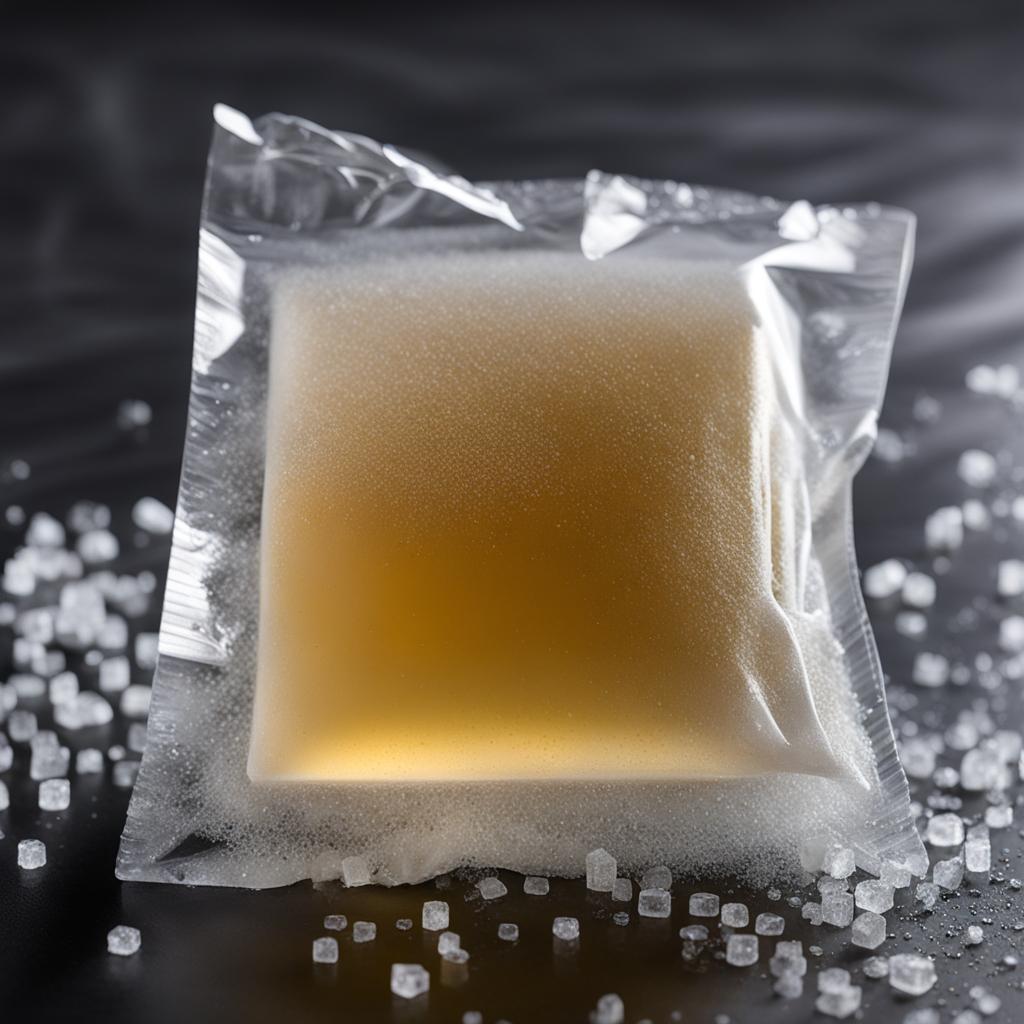Hey there! Have you ever opened a can of chicken broth, only to be greeted by an unpleasant smell or strange texture? It’s not a pleasant experience, and it can leave you wondering if the broth is still safe to consume. In this article, I’ll be sharing some essential tips on how to tell if your chicken broth has gone bad, ensuring that you can enjoy its freshness without any worries.
When it comes to assessing the quality of your chicken broth, there are a few key indicators of spoilage to keep in mind. By paying attention to visual, olfactory, and gustatory cues, as well as implementing proper storage and culinary practices, you can ensure the utmost safety and freshness of your chicken broth. Let’s dive in!
Key Takeaways:
- Visual cues like discoloration and unusual texture can indicate spoilage.
- Be mindful of any off-putting odors, such as a sour or rotten smell.
- If the taste of the chicken broth is significantly different or unpleasant, it may have gone bad.
- Proper storage techniques, including refrigeration and freezing, are crucial for maintaining freshness.
- Always check the expiration date and nutritional content of your chicken broth.
Recognizing Visual Cues
When it comes to determining whether your chicken broth has gone bad, visual cues can provide valuable insights. By visually inspecting the broth, you can look out for signs of spoilage, such as changes in color and texture.
Color: Take note of any discoloration in the chicken broth. If it looks significantly different from its original appearance, it may indicate spoilage. Look out for unusual hues, such as a greenish or grayish tinge. Fresh chicken broth should typically have a clear, golden color.
Texture: Pay attention to the texture of the broth. A healthy chicken broth should have a smooth and liquid consistency. If you notice any sliminess or the presence of clumps, it can be a sign that the broth has gone bad.
By keeping an eye out for these visual cues, you can make an informed decision about the freshness of your chicken broth.
| Visual Cues | Signs of Spoilage |
|---|---|
| Color | Discoloration (e.g., greenish or grayish tinge) |
| Texture | Sliminess or clumps |
Evaluating Color:
When evaluating the color of your chicken broth, compare it to its original appearance. Fresh broth typically has a clear, golden color. Any noticeable changes, such as discoloration or unusual hues, may indicate spoilage.
Assessing Texture:
Texture is an important visual cue to consider when determining the freshness of chicken broth. A healthy broth should have a smooth, liquid consistency. If you observe any sliminess or the presence of clumps, it is likely that the broth has gone bad.
Evaluating Odor
When it comes to determining if chicken broth has gone bad, one of the key indicators is the odor. Smelling the broth can give you valuable information about its freshness and safety.
“If the odor is off-putting, it is best to discard the broth to avoid any potential health risks.”
A strong, unpleasant smell from the chicken broth may be a sign that it has spoiled. This can manifest as a sour or rotten odor that is noticeably different from the normal aroma of fresh broth. Trust your senses and if the smell is concerning, it is better to be safe than sorry and throw it away.
Remember to use caution and avoid inhaling directly from the container, especially if the smell is pungent. Instead, consider pouring a small amount into a clean cup or bowl and taking a whiff from a safe distance.
By taking the time to evaluate the odor of your chicken broth, you can make an informed decision about its quality and ensure a safe and enjoyable culinary experience.
Tasting Your Way to Freshness
When it comes to assessing the quality of your chicken broth, there’s one sense that can never let you down: your taste buds. Taking a small sip and paying attention to the flavor can provide valuable insights into the freshness of your broth.
Trust your taste buds and discard the broth if it tastes off. A significantly different or unpleasant taste compared to its usual flavor can be a clear indicator that the chicken broth has gone bad. If you detect any sourness, bitterness, or an overall unpleasant taste, it’s best to err on the side of caution and not consume it.
“If it tastes bad, it’s time to toss it.” – Chef Jane
Remember, the taste test is particularly important when it comes to chicken broth as it can be a breeding ground for bacteria if not stored or handled properly. Don’t hesitate to rely on your taste buds to ensure a safe and enjoyable culinary experience.
| Signs of Bad Chicken Broth | Notes |
|---|---|
| Unpleasant taste | If the flavor is significantly different or unpleasant compared to its usual taste, it may have gone bad. |
| Sour or rotten smell | If the odor is off-putting, with a sour or rotten scent, it’s best to discard the broth to avoid any health risks. |
| Discoloration | Look for any changes in color from its original appearance, as it may be an indication of spoilage. |
| Unusual texture | If the broth appears slimy, has clumps, or an unusual texture, it may have gone bad. |
By using your taste buds as a tool in determining the freshness of your chicken broth, you can ensure that every spoonful is delicious and safe to consume.
Guidelines for Culinary Safety
When it comes to culinary safety in the kitchen, following a few essential guidelines can help ensure the freshness and quality of your meals. Whether you’re cooking homemade recipes or using store-bought ingredients like chicken broth, proper storage, handling, and usage are all key to maintaining food safety and maximizing shelf life.
Proper Storage and Shelf Life
When it comes to chicken broth, storing it correctly is imperative. If you have an unopened can or carton of chicken broth, keep it in a cool, dry place like your pantry until you’re ready to use it. Once opened, it’s important to refrigerate the broth and use it within the recommended time frame, usually about 4-5 days. If you don’t plan on using all the broth within that time, consider freezing it in airtight containers for longer storage.
It’s also crucial to be aware of the shelf life of your chicken broth. Check the expiration date on the packaging to ensure it’s still within the recommended period. While unopened chicken broth can typically last 2-3 years, its freshness decreases once opened, so be mindful of using it in a timely manner to maintain its quality.
Usage and Hygiene
When incorporating chicken broth into your recipes, it’s important to follow the instructions provided. Whether it’s using the broth as a base for soups, stews, or sauces, or adding it to rice or pasta dishes, using the recommended amount will ensure the desired flavor and consistency. Additionally, practicing good hygiene while handling and cooking with the broth, such as washing your hands thoroughly and keeping utensils and surfaces clean, is vital for avoiding cross-contamination.
Culinary Tips and Tricks
While culinary safety is paramount, there are other tips and tricks you can incorporate into your culinary endeavors. For example, if you have leftover chicken broth from a recipe, consider freezing it in ice cube trays for easy portioning in future dishes. You can also use chicken broth as a flavorful substitute for water when cooking grains like rice or quinoa.
Remember, maintaining culinary safety in the kitchen ensures not only the freshness and quality of your meals but also the overall enjoyment of your cooking experience. By following these guidelines for culinary safety, you can confidently create delicious and safe dishes for yourself and your loved ones.
| Guidelines for Culinary Safety | Key Points |
|---|---|
| Proper Storage and Shelf Life | – Store unopened chicken broth in a cool, dry place – Refrigerate opened broth and use it within 4-5 days – Consider freezing unused broth in airtight containers for longer storage |
| Usage and Hygiene | – Follow recipe instructions for using chicken broth – Practice good hygiene while handling and cooking with the broth |
| Culinary Tips and Tricks | – Freeze leftover broth in ice cube trays for easy portioning – Use chicken broth as a flavorful substitute for water in cooking grains |
Proper Storage Techniques
When it comes to maintaining the freshness and quality of your chicken broth, proper storage techniques are key. Whether you have an opened or unopened container, ensuring that the broth is stored correctly will help preserve its flavor and prevent spoilage. Here are some guidelines for storing chicken broth in the refrigerator and freezer:
Refrigerator Storage
Once you have opened a can or carton of chicken broth, it is important to store it in the refrigerator to keep it fresh. Transfer the broth into an airtight container or cover the original packaging tightly with plastic wrap. This will help prevent any odors from contaminating the broth and maintain its taste. Be sure to label the container with the date it was opened, so you can keep track of its freshness. In the refrigerator, chicken broth typically stays good for about 4-5 days.
Freezer Storage
If you have excess chicken broth or want to stock up for future use, freezing is an excellent option. First, make sure the broth has cooled completely before transferring it to freezer-safe containers. Leave some headspace in the containers as liquids expand when frozen. Label the containers with the date and quantity of broth for easy identification later on. When properly stored in the freezer, chicken broth can last for up to 3 months.
| Storage Method | Duration |
|---|---|
| Refrigerator (opened) | 4-5 days |
| Freezer | Up to 3 months |
By following these storage techniques, you can maximize the shelf life of your chicken broth and ensure that it remains safe to consume. Whether you choose to refrigerate or freeze the broth, always check for any signs of spoilage before using it in your recipes. Remember, proper storage is essential for maintaining the freshness and quality of your chicken broth.
Understanding Shelf Life
When it comes to chicken broth, understanding its shelf life is crucial for maintaining its freshness and quality. Shelf life refers to the length of time a product can be stored before it starts to deteriorate in terms of taste, texture, and safety. For chicken broth, the shelf life can vary depending on whether it is unopened or opened, as well as how it is stored.
Unopened chicken broth that is stored properly can typically last for about 2-3 years. It is important to check the expiration date on the packaging to ensure you are consuming it within its recommended shelf life. Once the broth is opened, its freshness starts to decrease, and it is best to consume it within 4-5 days to maintain its quality and safety. Always remember to refrigerate the opened broth promptly to prevent bacterial growth.
Proper Storage Techniques
The shelf life of chicken broth can be extended by following proper storage techniques. When storing unopened broth, keep it in a cool, dry place like a pantry. Once opened, transfer the broth to the refrigerator and use it within the recommended time frame. If you have leftover broth that you don’t plan on using within a few days, consider freezing it in airtight containers. Frozen chicken broth can maintain its quality for several months.
| Storage Method | Shelf Life |
|---|---|
| Unopened in the pantry | 2-3 years |
| Opened in the refrigerator | 4-5 days |
| Frozen in airtight containers | Several months |
By understanding the shelf life of chicken broth and implementing proper storage techniques, you can ensure that your broth remains fresh and safe to consume. It’s always a good idea to label and date your containers to keep track of freshness, especially when freezing portions of broth for later use. Knowing how long chicken broth can be stored will not only save you from potential food waste but also ensure that your recipes turn out delicious every time.
Importance of Nutrition
When it comes to chicken broth, nutrition is an important aspect to consider. Not only is chicken broth a flavorful ingredient in many recipes, but it also provides essential vitamins and minerals that contribute to a balanced diet. However, it’s crucial to ensure the safety and freshness of your chicken broth to reap its nutritional benefits.
Chicken broth is a perishable food item, and if it spoils, it can pose a risk to your health. Proper handling, storage, and usage are key to maintaining the nutritional value of your broth. Ensure that you follow food safety guidelines to prevent any potential contamination.
Food safety should always be a top priority when dealing with perishable items like chicken broth. By practicing good hygiene, storing the broth at the right temperature, and using it within the recommended time frame, you can ensure that you’re consuming a safe and nutritious product.
Table 8.1: Nutritional Content of 1 cup of Chicken Broth
| Nutrient | Amount |
|---|---|
| Protein | 8g |
| Calcium | 8mg |
| Potassium | 96mg |
| Vitamin A | 15 IU |
| Vitamin C | 0mg |
“Chicken broth can be a nutritious addition to your meals, providing protein and essential minerals. However, it’s important to handle it with care and ensure that it hasn’t spoiled to avoid any health risks.” – Food Safety Expert
Remember, the key to enjoying the nutritional benefits of chicken broth is to prioritize food safety. By understanding the perishable nature of this ingredient and implementing proper storage and usage practices, you can savor the flavors of your favorite recipes while nourishing your body with essential nutrients.
Best Practices in Grocery Shopping
When it comes to grocery shopping, it’s important to prioritize food safety and make informed choices. Here are some essential food tips and ingredient selection strategies to keep in mind during your next trip to the store.
Check the Packaging
Before adding chicken broth to your cart, carefully examine the packaging for any signs of damage or bulging. Damaged or bulging cans may be a red flag, indicating that the broth may have been compromised or spoiled. Opt for packaging that is intact and free from any visible defects.
Choose Reputable Brands
When it comes to food safety, choosing reputable brands can provide added assurance. Look for well-known and trusted brands that prioritize quality and adhere to strict safety standards. These brands often invest in quality assurance practices to ensure the freshness and safety of their products.
“Choosing reputable brands can provide added assurance of food safety and quality.”
Check for Quality Assurance Labels
Quality assurance labels or certifications on the packaging signify that the chicken broth has undergone rigorous testing and meets industry standards for safety and quality. Keep an eye out for these labels, such as USDA Organic, Non-GMO Project Verified, or third-party certification seals, which indicate that the broth has met specific criteria.
Consider Expiration Dates
When selecting chicken broth, pay attention to the expiration dates on the packaging. Choose broth with a later expiration date to maximize its freshness and shelf life. By opting for products with longer expiration dates, you can ensure that you have ample time to use the broth before it reaches its recommended date of consumption.
Make Informed Choices
Being mindful of food safety and making informed choices during grocery shopping can help ensure the quality and freshness of your chicken broth. By checking packaging, opting for reputable brands, looking for quality assurance labels, and considering expiration dates, you can have confidence in the products you bring home.
Tips for Homemade Broth
When it comes to homemade broth, there are a few important tips to keep in mind to ensure its quality and flavor. The process of making your own broth allows you to control the ingredients and tailor it to your taste preferences. Here are some key tips to follow:
1. Use Fresh Ingredients:
Start with high-quality ingredients, such as fresh chicken bones and vegetables. Using fresh ingredients will significantly enhance the flavor and nutritional value of your broth. Avoid using ingredients that have gone bad or are past their prime.
2. Cook Thoroughly:
Simmer the ingredients for an extended period to extract all the flavors and nutrients. Slow cooking allows the flavors to meld together, resulting in a rich and flavorful broth. Skim off any impurities that rise to the surface while cooking to ensure a clear and clean broth.
3. Proper Storage:
Once your broth is ready, it’s important to store it properly to maintain its freshness and quality. Allow the broth to cool completely before transferring it to airtight containers. Label the containers with the date and contents for easy reference. Store the broth in the refrigerator and use it within a few days, or freeze it for longer-term storage.
| Ingredient | Quantity |
|---|---|
| Chicken Bones | 2-3 pounds |
| Vegetables (carrots, celery, onions) | 2-3 cups, chopped |
| Herbs and Spices (bay leaves, thyme, peppercorns) | To taste |
| Water | 8-10 cups |
Remember, homemade broth can elevate your recipes and add a depth of flavor that store-bought versions often lack. With a little effort and attention to detail, you can enjoy the satisfaction of creating your own delicious broth.
The Role of Freezing
Freezing chicken broth is a valuable technique to extend its shelf life and ensure its availability for future recipes. By carefully storing and labeling the broth, you can conveniently use it whenever needed. Freezing not only preserves the freshness of the chicken broth but also allows for portion control and eliminates unnecessary wastage.
When freezing chicken broth, divide it into small portions based on your recipe requirements. This way, you can easily thaw and use only the amount needed, preventing any potential food waste. It is important to label and date the containers to keep track of the frozen broth and ensure you use the oldest ones first.
Additionally, consider using freezer-safe and airtight containers to maintain the quality of the chicken broth during freezing. This helps to minimize the risk of freezer burn and preserve the flavor and texture of the broth. Make sure to leave some space at the top of the container to accommodate expansion during freezing.
| Freezing Chicken Broth | Key Points |
|---|---|
| Divide into small portions | Allows for portion control and prevents waste |
| Label and date containers | Keep track of frozen broth and use oldest first |
| Use freezer-safe containers | Preserve flavor and texture, minimize freezer burn |
When it comes time to use the frozen chicken broth, simply thaw it in the refrigerator overnight or use the defrost function on your microwave if you need it more quickly. Once thawed, use the broth within a few days and do not refreeze it to maintain its quality. Incorporating frozen chicken broth into your cooking allows for added convenience and ensures that you have a versatile ingredient on hand whenever needed.

Benefits of Freezing Chicken Broth:
- Extends the shelf life of the broth
- Allows for portion control and reduces food waste
- Preserves the flavor and texture
- Convenient and versatile ingredient for future recipes
Maximizing Shelf Life of Store-Bought Broth
When it comes to store-bought chicken broth, ensuring its longevity is essential for both convenience and freshness. By following proper storage techniques and guidelines, you can make the most out of your purchase and enjoy the full flavor of the broth for longer periods. Here are some tips to help you maximize the shelf life of your store-bought chicken broth:
Properly Store the Broth
One of the key factors in extending the shelf life of store-bought chicken broth is proper storage. After opening the broth, make sure to transfer it to an airtight container. This will prevent exposure to air and bacteria, which can cause the broth to spoil more quickly. Store the container in the refrigerator, where the cold temperature will help slow down the growth of bacteria and maintain the freshness of the broth. Remember to label the container with the date of opening to keep track of its shelf life.
Adhere to Expiration Dates
Before purchasing store-bought chicken broth, always check the expiration date on the packaging. This date indicates the recommended period within which the broth is at its peak freshness. To maximize the shelf life, select broth with a later expiration date. Additionally, be sure to consume the broth within the recommended time frame after opening, typically 4-5 days. Adhering to these dates will help ensure that you are enjoying the best quality and flavor of your store-bought chicken broth.
Implement Good Hygiene Practices
To maintain the longevity of your store-bought chicken broth, it is crucial to practice good hygiene while handling the broth. Always use clean utensils and containers when scooping or pouring the broth. Avoid double-dipping utensils that have come into contact with other foods, as this can introduce bacteria into the broth. By implementing these hygienic practices, you can prevent contamination and extend the shelf life of your store-bought chicken broth.
By storing your store-bought chicken broth properly, adhering to expiration dates, and implementing good hygiene practices, you can maximize its shelf life and ensure that you always have a fresh and flavorful supply on hand. With these simple tips, you can confidently enjoy the convenience and deliciousness of store-bought chicken broth in your favorite recipes.
Quality Assurance in Commercial Broth
When it comes to store-bought chicken broth, quality assurance is essential to ensure that you are purchasing a safe and reliable product. Look for reputable brands that prioritize quality and safety. Many manufacturers implement rigorous testing measures and adhere to strict standards to ensure their broth meets the highest quality control standards.
One way to identify quality assurance in commercial broth is by looking for certifications or quality assurance labels on the packaging. These labels indicate that the broth has undergone thorough testing processes to guarantee its safety and quality. These certifications can provide consumers with peace of mind when choosing a store-bought chicken broth.
By selecting broth with quality assurance labels, you can trust that the product is made with high-quality ingredients and meets stringent safety guidelines. This can help ensure the freshness, flavor, and nutritional value of the chicken broth you purchase. Remember to always check the packaging for quality assurance labels before making your selection.
Buying in Bulk and Expiry Date Management
When it comes to stocking up on chicken broth, buying in bulk can be a cost-effective and convenient option. However, it’s important to pay attention to the expiration dates on the packaging to ensure that you don’t end up with expired broth in your pantry. Proper management of expiry dates is essential for maintaining the freshness and quality of your chicken broth.
To effectively manage expiry dates, it’s crucial to implement a rotation system for your chicken broth stock. When you purchase new broth, place it at the back of your stock and bring the older broth to the front. This way, you can use the older broth first, ensuring that none of it sits beyond its recommended shelf life. By rotating your stock, you can minimize food waste and ensure that you always have fresh chicken broth on hand.

Creating a simple spreadsheet or inventory list can also help you keep track of the expiry dates of your chicken broth. Note down the purchase date and the expiration date for each batch of broth you buy. This way, you’ll have a clear overview of when each batch needs to be used by, making it easier to plan your meals accordingly.
Table: Example Expiry Date Inventory
| Batch | Purchase Date | Expiration Date |
|---|---|---|
| 1 | June 1, 2022 | September 1, 2023 |
| 2 | August 15, 2022 | November 15, 2023 |
| 3 | October 3, 2022 | January 3, 2024 |
By following these bulk buying and expiry date management tips, you can ensure that you always have a fresh supply of chicken broth for your culinary creations. With proper planning and organization, you can make the most out of your bulk purchases while minimizing food waste and maintaining the quality of your broth.
Reducing Food Waste
In today’s world, where sustainability is becoming increasingly important, reducing food waste is a crucial goal for every kitchen. By adopting simple cooking tips and creative ideas for utilizing leftovers, you can make a significant impact on minimizing food waste and maximizing the use of your ingredients.
One effective way to combat food waste is by planning meals ahead and using up ingredients before they spoil. Consider creating a weekly meal plan to ensure that you utilize the ingredients you have on hand. This not only reduces the chances of food going bad but also helps you save time and money by preventing unnecessary trips to the grocery store.
Another smart approach to reducing food waste is repurposing leftovers. Leftover chicken broth, for example, can be utilized in a variety of recipes. Use it as a base for flavorful soups, stews, or risottos, or incorporate it into sauces or gravies to add richness and depth of flavor.
| Creative Uses for Leftover Chicken Broth |
|---|
| Chicken Noodle Soup |
| Vegetable Stew |
| Mushroom Risotto |
| Homemade Gravy |
Remember, reducing food waste not only benefits the environment but also allows you to explore new flavors and expand your culinary repertoire. So next time you find yourself with leftover chicken broth, get creative and turn it into a delicious new dish!
Conclusion
In conclusion, knowing how to tell if chicken broth has gone bad is essential for maintaining the freshness and safety of your meals. By paying attention to visual cues, evaluating odor and taste, practicing proper storage and hygiene, and understanding shelf life, you can confidently enjoy your chicken broth while ensuring its quality.
When visually inspecting the broth, look for any discoloration or unusual texture, such as sliminess or clumps. Trust your nose to detect any sour or rotten odors that indicate spoilage. Additionally, take a small sip to assess the taste, and discard the broth if it has a significantly different or unpleasant flavor.
Remember to store the chicken broth properly in the refrigerator or freezer, adhering to recommended shelf life guidelines. Follow good culinary practices in the kitchen, such as using it in recipes according to instructions and practicing hygiene while handling and cooking with the broth. By implementing these tips, you can enjoy your chicken broth while minimizing the risk of consuming spoiled broth.
So, embrace these guidelines to ensure the freshness and safety of your chicken broth. By doing so, you can savor the flavorful benefits of this ingredient, enhancing the taste and richness of your culinary creations.
FAQ
How can I tell if chicken broth has gone bad?
You can check for signs of spoilage such as discoloration or unusual texture, smell for any sour or rotten odors, and taste for any significant changes in flavor.
What are some visual cues to look for in spoiled chicken broth?
Watch out for any discoloration, such as a change in color from its original appearance, and pay attention to the texture. If it appears slimy or has clumps, it may have gone bad.
How can I evaluate the odor of chicken broth?
Smell the chicken broth to determine if it has a strong, unpleasant odor. Spoiled chicken broth may emit a sour or rotten smell.
How can I test the taste of chicken broth?
Take a small sip of the chicken broth and assess its taste. If it has a significantly different or unpleasant taste compared to its usual flavor, it may have gone bad.
What are some guidelines for culinary safety with chicken broth?
Properly store chicken broth in the refrigerator or freezer, adhere to recommended shelf life, use it in recipes according to instructions, and practice good hygiene while handling and cooking with the broth.
How should I store chicken broth to maintain its freshness?
If unopened, keep it in a cool, dry place like a pantry. Once opened, store it in the refrigerator and use it within a specified time frame. Alternatively, freeze the broth in airtight containers for longer storage.
What is the shelf life of chicken broth?
Unopened chicken broth typically has a shelf life of about 2-3 years when stored properly. Once opened, it should be consumed within 4-5 days. Always check the expiration date on the packaging for guidance.
Is chicken broth nutritionally beneficial?
Yes, chicken broth is a good source of vitamins and minerals. Proper handling, storage, and usage can help maintain its nutritional value and reduce the risk of consuming spoiled broth.
What should I look for when buying store-bought chicken broth?
Examine the packaging for any signs of damage or bulging. Choose broth from reputable brands and check for quality assurance labels. Select broth with a later expiration date for maximum freshness.
How can I make homemade chicken broth?
Ensure that you follow proper cooking and storage techniques. Use fresh ingredients, cook the broth thoroughly, and store it in appropriate containers. Label and date the containers for easy tracking of freshness.
Can I freeze chicken broth?
Yes, freezing chicken broth can extend its shelf life. Divide the broth into small portions and freeze them in airtight containers. Remember to label and date the containers for easy identification.
How can I maximize the shelf life of store-bought chicken broth?
Pay attention to the recommended storage guidelines on the packaging. Implement proper storage techniques to maintain the longevity of the broth and ensure its freshness when used.
How can I ensure the quality of store-bought chicken broth?
Look for quality assurance labels or certifications on the packaging. These indicate that the broth has undergone rigorous testing and meets strict standards of safety and quality.
What should I consider when buying chicken broth in bulk?
Pay attention to the expiration dates on the packaging. Rotate your stock to use older broth first and avoid letting any broth sit beyond its recommended shelf life.
How can I reduce food waste with chicken broth?
Utilize leftovers by incorporating them into new recipes. Get creative with using leftover chicken broth in soups, stews, risottos, or sauces. Plan meals ahead and use up ingredients before they spoil.
What are the key points to remember about chicken broth spoilage?
By following visual cues, evaluating odor and taste, practicing proper storage and hygiene, and understanding shelf life, you can confidently enjoy your chicken broth while ensuring its quality.
Source Links
- https://www.latimes.com/archives/la-xpm-1987-09-24-fo-9721-story.html
- https://www.latimes.com/food/dailydish/la-dd-kroger-turns-spoiled-food-into-electricity-how-do-you-reduce-waste-20130516-story.html
- https://catholicallyear.com/blog/how-we-stopped-throwing-away-food/
Related Recipes:
 How to Tell if Chicken Broth Has Gone Bad: Safety Tips
How to Tell if Chicken Broth Has Gone Bad: Safety Tips
 How to Store Chicken Safely
How to Store Chicken Safely
 How to Store Chicken Safely
How to Store Chicken Safely
 Can You Eat Expired Butter? What You Need to Know
Can You Eat Expired Butter? What You Need to Know
 How to Store Ham to Maintain Its Flavor
How to Store Ham to Maintain Its Flavor
 Does Almond Milk Go Bad? How to Tell and Storage Tips.
Does Almond Milk Go Bad? How to Tell and Storage Tips.
 How Long Can Cooked Chicken Sit Out? Safety Tips.
How Long Can Cooked Chicken Sit Out? Safety Tips.
 Does Peanut Butter Go Bad? Shelf Life and Storage Tips
Does Peanut Butter Go Bad? Shelf Life and Storage Tips








